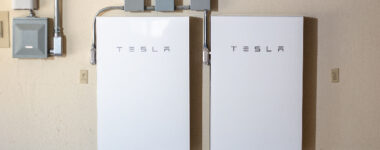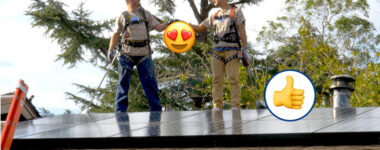Solar Power San Diego | Solar Panels, Battery Storage, Roofing, HVAC
Having a solar panel system installed can be an environmentally and economically savvy move. In fact, the Solar Energy Industries Association reported that the market doubled in 2016 compared to the previous year. Solar power is not a fading trend – it is here to make the world a greener place. With the wave of solar power comes additional renewable energy options for homeowners, including options like solar batteries for storing solar power not used right away. What Exactly Do Solar Batteries Do? When a homeowner has a solar energy system installed, it includes solar panels, mounting equipment, a monitoring system, and an inverter to make the power from the sun usable electricity in a home. Most homes are tied to an electricity grid, which means any additional or unused power created by your panels will flow into the grid. In return, homeowners are able to draw excess power needed when their solar panels aren’t producing enough (such as at night). Typically, a credit will be given to homeowners for any extra electricity their solar panels produce and send to the grid. That means these credits will usually cover any excess electricity needed to be drawn back from the grid when the panels aren’t generating enough power– also referred to as net metering. So what does this have to do with solar batteries? In theory, the batteries would take that excess solar power, convert it, and then store it for later use. The solar battery would then be the secondary power source your home draws from depending on how much power your solar panels produce. Any excess electricity produced by panels once the battery is charged is then sent back to the grid. It essentially gives your home an extra storage of usable electricity. If your solar battery is depleted when your panels aren’t producing power, only then will your home draw from the grid. Additionally, solar batteries can act as a quick backup power supply in power outage situations. Do I Need a Solar Battery for My Home? Having a solar battery may seem like a natural step to take when you have a solar panel system up and running for your home, but it isn’t always necessary. In large part, whether or not a battery is practical depends on how your utility processes the power produced by your solar panels. If you get compensated through a credit for every kilowatt-hour of electricity produced (net metering), a battery may not make as much sense. If a battery is storing that power, you won’t get any extra savings on your electricity bill. On the other hand, if you are under time-of-use rates or demand charges, you may benefit greatly from having the flexibility of a solar battery to provide previously produced power during those times. Also, if you like the idea of being able to store additional solar power and reducing dependence on the local electricity grid, a solar battery can be a great option. Still have questions? You can get answers when you trust your solar panel system installation to Semper Solaris. Contact us now to get more insight on how to go solar the smart way.
Are you ready to embrace the solar revolution and get solar panels for your home? Solar power in San Diego is a big investment that will affect your monthly energy costs and impact the value of your home. That’s why it’s so important to choose the right solar installation company. You have many solar installation companies to choose from in San Diego, but how do you find the right one? Every solar panel company will be more than happy to point you to their testimonial page, which (surprise, surprise) is usually filled with ecstatic praise. How can you find honest, unbiased customer reviews to help you determine if a solar company in San Diego is a diamond or a dud? Why Reviews Matter Solar energy in San Diego is big business, and a lot of companies are jumping on the solar installation bandwagon. One of the best ways to determine if a solar installation company will do a good job for you in the future is to find out how they’ve performed in the past. If a company has done shoddy work for previous customers, chances are they won’t miraculously change their behavior and provide you with an excellent result. This is why reviews are one of the most useful tools for evaluating and ultimately choosing a solar power company in San Diego. What to Look for in Reviews When you begin searching for solar company reviews, you may be surprised by how many you find. Top solar companies may have hundreds of reviews. How do you evaluate each of these reviews and effectively compare them with the reviews of a different company? Keep in mind that reviews are a tool that you can use to better understand the characteristics, strengths, and benefits of each company. When reading reviews, here are some important factors to look for: Location Is the company national, or is it local? If the company has multiple offices, make sure to read reviews for the nearest location to you. It’s important to ensure that a solar installation company has worked in your area, understands the popular roofing styles in your region, and is well-versed in the local permitting rules and regulations. Communication Good communication is at the heart of every successful solar installation. While you read a company’s reviews, look for indications that the company thoroughly explained the installation process to the homeowner and guided them in choosing the solar system size and the best financing option. Look for notes on if the company answered all the consumer’s questions and responded quickly to their concerns. Timing This one is simple. Was the company able to send a team out to perform the installation in a timely manner, and did the company meet its deadline? Budget Did the reviewer feel that the company listened to and abided by their budget requirements when recommending a solar system size and the brand of solar panels? Did the company stay within the budget? Problems Even if a solar company does everything right, problems and other surprises are still bound to happen. Maybe there’s an issue pulling a permit, the solar panels don’t arrive on time, or the project manager discovers a roofing issue that needs to be repaired. The true test of a company is how they handle the unexpected. When problems arise, did the company communicate with the homeowner? Did they provide solutions? Was the homeowner ultimately happy with how the problem was resolved? Overall Satisfaction When reading the reviews, note how many customers were happy versus unhappy. The best endorsement a homeowner can give is to say that they would recommend a company to their family and friends. Company Response Even the best solar companies can’t satisfy everyone, and not every homeowner has reasonable expectations. Just because a company has a few bad reviews doesn’t necessarily mean that it should be taken out of consideration. Most review sites allow companies to respond to reviews. If a company has one or two particularly bad reviews, take the time to read their response (a good company should respond to all negative reviews). This will give you a chance to understand their side of the story. Where to Find Solar Company Reviews Now that you know why reviews are important and what to look for in reviews, there’s just one more thing you should know – how to actually find reviews of solar installation companies! Fortunately, you have plenty of options. Here are the top four review sources that can give you great insights into your local solar power companies in San Diego. Better Business Bureau The Better Business Bureau (BBB) has been around since 1912 and is one of the most trusted and well-respected consumer protection institutions in the world. It allows consumers to write reviews of companies and file complaints against companies, which the BBB will then attempt to resolve. It currently includes more than four million consumer reviews. Businesses can seek special accreditation from the BBB, which signifies that they agree to abide by the BBB’s strict ethical standards and agree to be monitored for compliance. We strongly encourage consumers to only work with BBB-accredited businesses when possible. Accreditation shows that a business is serious about providing the very best customer service. Where We Stand: Semper Solaris has been accredited by the BBB since 2013 and currently has an A+ rating with the organization. See our BBB reviews. Angie’s List Angie’s List is a customer review site that specializes in gathering reviews for home service companies, including plumbers, remodeling contractors, and solar installers. Angie’s List has a strong reputation for quality, honest reviews and takes a lot of precautions to remove fake reviews. For example, all reviews are vetted by the company’s staff, and members can only submit one review every six months. The company receives roughly 60,000 reviews every month for over 720 different services. Reviewers on Angie’s List can rate service providers on a number of factors, giving you a better sense of how the company performs in areas like Response Time, Professionalism, and Quality of Work. Where We Stand: Semper Solaris currently holds an “A” rating on Angie’s List for Price, Quality, Responsiveness, Punctuality, and Professionalism. We earned a Super Service Award in 2016. See our Angie’s List reviews. Yelp Founded in 2004, Yelp is the biggest crowdsourced review site in the U.S. The site has collected over 155 million reviews on just about everything you can imagine, from your favorite brewery to the doggy daycare down the street. Yelp can usually provide the highest quantity of reviews, but the site has also struggled at times to effectively filter out fake reviews. It also does not require reviewers to provide their names, which can lead to anonymous reviews that might not be entirely trustworthy. How We Do: With more than 200 reviews on Yelp, Semper Solaris has a 4.5 star rating (out of 5 possible stars). See our Yelp Reviews. SolarReviews As its name implies, SolarReviews is a company that specializes in the solar industry. While the company’s main business is providing solar installation company referrals to consumers, it also includes robust crowdsourced reviews of installation companies, solar panels, and solar batteries. SolarReviews also offers a “Solar Pro” accreditation program to help consumers pre-screen solar installation companies. The accreditation requires, among other things, that a company have at least three years of experience installing solar panels, possess the correct licensing, and achieve a satisfaction score of at least 4.5 out of 5 stars. How We Do: With more than 200 reviews, Semper Solaris holds a 4.9-star score with SolarReviews. We are also proud to be an accredited Solar Pro and to be ranked as one of the company’s top 10 solar installers for 2018! See our reviews on SolarReviews. Do Your Solar Homework Don’t trust your solar panels and your roof to an unknown company. Check out their reviews. Any solar energy company in San Diego can slap a couple of positive (and possibly edited) customer testimonials on their site. The true test of a good installer is whether they invite you to check out their reviews on crowdsourced sites, like the BBB, Angie’s List, Yelp, and SolarReviews where they can’t pick or edit the reviews. The best companies, in the end, will earn the best reviews. At Semper Solaris, we work extremely hard to make sure every customer is thrilled when they choose us to install their solar power system in San Diego. Our great customer service has resulted in hundreds of positive reviews and high rankings on every major review site. We invite you to read all of our reviews and then to schedule a no-pressure, no-cost energy analysis. We hope that you’ll be writing a great review of our service someday soon!

